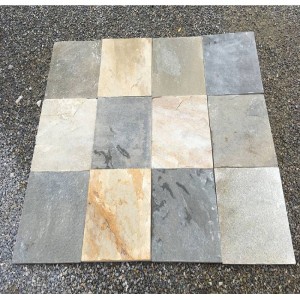
A few advantages and disadvantages of installing stone flooring in your home.
Stone is very durable, it won’t date but will improve with age, it is very traditional and will work with any design scheme as your interior fashions change over the years. Getting the basics right will make your life easier in the long term.
The colours tend to be neutral and each stone is unique and can create different looks, for example;
Limestone – a popular choice, light in colour, durable and highly versatile, coming in many different styles to suit any room. Here is our Classical Flagstones Jura Grey Honed Limestone Tile

Travertine – can add flair to any room on both walls and floors in creamy colours, it is hard-wearing and versatile. This is an example of our Classical Flagstones Corusante Travertine Tile
Slate & Quartzite – Floors and walls, can choose from several shades of grey (hints of green, russet, hazel and plum)
Some stone can be used outside and indoors – e.g. Slate/ Limestone.
Stone is a work of art by nature, It creates floors of intriguing texture and character
Stone reduces symptoms of asthma or allergy sufferers.
The perception is that a stone floor can be cold; however this of course is a benefit when the weather is hot but for when it is colder this can be overcome with under floor heating, and of course once warmed it retains the heat really well.
Stone flooring requires maintenance, and regular washing and cleaning every alternate day, and if you do not do so, then the stones would start to deteriorate. This can be very time-consuming process, and that is the main reason that stone flooring is not introduced throughout the whole house. See our range of sealers, cleaners ۽ polishes for your stone floor maintenance.
Stone’s strength can make falls more dangerous for both people and objects. It can also be slippery when wet. The finish and sealant can help make stone less slippery. Contact us for more information on this
Stone is suitable for use throughout the home ideally in heavy traffic areas, most typically: halls, kitchens, sitting rooms (where they look great adorned with colourful rugs), bathrooms and conservatories.
You can use the same stone throughout to extend your living space and create a natural flow into your garden ‘bringing the indoors, outdoors and the outdoors, indoors’.
Bathrooms – Choose Marble and Travertine for their sleek, clean lines and Mosaics are perfect for use as insets or on their own and lend themselves particularly to areas where dampness and humidity will require a slip resistant surface.
Kitchens – Choice is varied, Limestone is not only beautiful to look at but it is also durable, practical and highly versatile. Stone is perfect for kitchens especially with people and animals tracking the great outdoors through the house and although a very traditional form of flooring it is now extremely fashionable and features in most large kitchens which are also used as a main living area.
Stone is just a fantastic choice for flooring for so many reasons, from its great good looks to its versatility and of course its longevity.